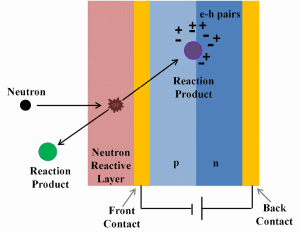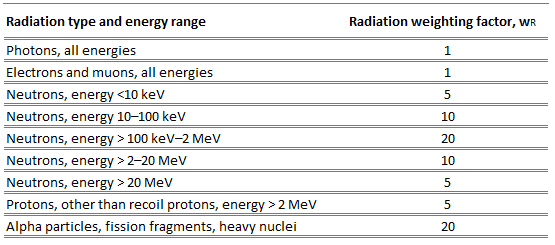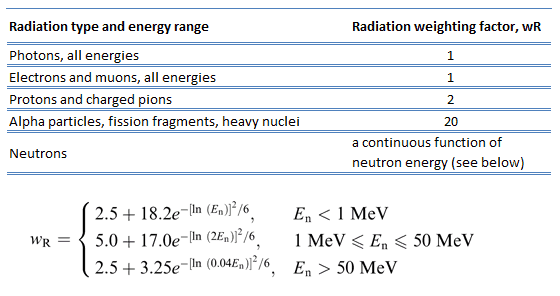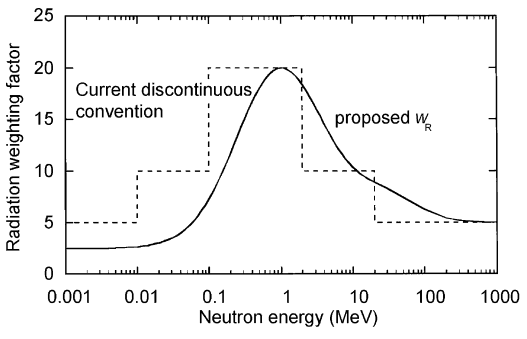
Source: large.stanford.edu
Neutron dosimetry is very specific since the neutrons are electrically neutral particles, and thus they are mainly subject to strong nuclear forces but not electric forces. Therefore, neutrons are not directly ionizing and usually must be converted into charged particles before they can be detected. Generally, every type of neutron detector must be equipped with a converter (to convert neutron radiation to common detectable radiation) and one of the conventional radiation detectors (scintillation detector, gaseous detector, semiconductor detector, etc.).
Studies have shown that alpha and neutron radiation cause greater biological damage for a given energy deposition per kg of tissue than gamma radiation. Biological effects of any radiation increase with the linear energy transfer (LET). In short, the biological damage from high-LET radiation (alpha particles, protons, or neutrons) is much greater than that from low-LET radiation (gamma rays). This is because the living tissue can more easily repair damage from radiation spread over a large area than that concentrated in a small area. Because more biological damage is caused for the same physical dose (i.e., the same energy deposited per unit mass of tissue), one gray of alpha or neutron radiation is more harmful than one gray of gamma radiation. The fact that radiations of different types (and energies) give different biological effects for the same absorbed dose is described in terms of factors known as the relative biological effectiveness (RBE) and the radiation weighting factor (wR).
Radiation Weighting Factors – ICRP
For photon and electron radiation, the radiation weighting factor has the value of 1 independently of the energy of the radiation, and for alpha radiation, the value is 20. For neutron radiation, the value is energy-dependent and amounts to 5 to 20.

In 2007 ICRP published a new set of radiation weighting factors(ICRP Publ. 103: The 2007 Recommendations of the International Commission on Radiological Protection). These factors are given below.

As shown in the table, a wR of 1 is for all low-LET radiations, i.e., X-rays and gamma rays of all energies as well as electrons and muons. A smooth curve, considered an approximation, was fitted to the wR values as a function of incident neutron energy. Note that En is the neutron energy in MeV.

Thus, for example, an absorbed dose of 1 Gy by alpha particles will lead to an equivalent dose of 20 Sv, and an equivalent dose of radiation is estimated to have the same biological effect as an equal amount of absorbed dose of gamma rays, which is given a weighting factor of 1.
Detection of Thermal Neutrons
Thermal neutrons are in thermal equilibrium with a surrounding medium of the temperature of 290K (17 °C or 62 °F). Most probable energy at 17°C (62°F) for Maxwellian distribution is 0.025 eV (~2 km/s). This part of the neutron’s energy spectrum constitutes the most important part of the spectrum in thermal reactors.
Thermal neutrons have a different and often much larger effective neutron absorption cross-section (fission or radiative capture) for a given nuclide than fast neutrons.
In general, there are many detection principles and many types of detectors. In nuclear reactors, gaseous ionization detectors are the most common since they are very efficient, reliable, and cover a wide range of neutron flux. Various types of gaseous ionization detectors constitute the so-called excore nuclear instrumentation systems (NIS). The excore nuclear instrumentation system monitors the reactor’s power level by detecting neutron leakage from the reactor core.
Detection of Neutrons using Ionization Chamber
Ionization chambers are often used as the charged particle detection device. For example, if the inner surface of the ionization chamber is coated with a thin coat of boron, the (n, alpha) reaction can occur. Most of (n,alpha) reactions of thermal neutrons are 10B(n,alpha)7Li reactions accompanied by 0.48 MeV gamma emission.
Moreover, isotope boron-10 has a high (n, alpha) reaction cross-section along the entire neutron energy spectrum. The alpha particle causes ionization within the chamber, and ejected electrons cause further secondary ionizations.
Another method for detecting neutrons using an ionization chamber is to use the gas boron trifluoride (BF3) instead of air in the chamber. The incoming neutrons produce alpha particles when they react with the boron atoms in the detector gas. Either method may be used to detect neutrons in a nuclear reactor. It must be noted that BF3 counters are usually operated in the proportional region.
Detection of Fast Neutrons
Fast neutrons are neutrons of kinetic energy greater than 1 MeV (~15 000 km/s). In nuclear reactors, these neutrons are usually named fission neutrons. The fission neutrons have a Maxwell-Boltzmann energy distribution with mean energy (for 235U fission) of 2 MeV. In a nuclear reactor, the fast neutrons are slowed down to the thermal energies via neutron moderation. These neutrons are also produced by nuclear processes such as nuclear fission or (ɑ,n) reactions.
In general, there are many detection principles and many types of detectors. But it must be added detection of fast neutrons is a very sophisticated discipline since fast neutrons cross section are much smaller than in the energy range for slow neutrons. Fast neutrons are often detected by first moderating (slowing) them to thermal energies. However, during that process, the information on the original energy of the neutron, its direction of travel, and the time of emission is lost.
Proton Recoil – Recoil Detectors
The most important type of detectors for fast neutrons are those directly detecting recoil particles, particularly recoil protons resulting from elastic (n, p) scattering. Only hydrogen and helium nuclei are light enough for practical application. In the latter case, the recoil particles are detected in a detector, and neutrons can transfer more energy to light nuclei. This method is appropriate for detecting fast neutrons and detecting fast neutrons without a moderator. This method allows the energy of the neutron to be measured together with the neutron fluence, i.e., the detector can be used as a spectrometer. Typical fast neutron detectors are liquid scintillators, helium-4-based noble gas detectors, and plastic detectors (scintillators). For example, plastic has a high hydrogen content. Therefore, it is useful for fast neutron detectors when used as a scintillator.
Bonner Spheres Spectrometer
There are several methods for detecting slow neutrons and a few methods for detecting fast neutrons. Therefore, one technique for measuring fast neutrons is to convert them to slow neutrons and then measure the slow neutrons. One possible method is based on Bonner spheres. The method was first described in 1960 by Ewing and Tom W. Bonner and employed thermal neutron detectors (usually inorganic scintillators such as 6LiI) embedded in moderating spheres of different sizes. Bonner spheres have been used widely to measure neutron spectra with neutron energies ranging from thermal up to at least 20 MeV. A Bonner sphere neutron spectrometer (BSS) consists of a thermal-neutron detector, polyethylene spherical shells, and two optional lead shells of various sizes. A 3He detector or inorganic scintillators such as 6LiI can be used to detect thermal neutrons. LiGlass scintillators are very popular for the detection of thermal neutrons. The advantage of LiGlass scintillators is their stability and a large range of sizes.
Detection of Neutrons using Scintillation Counter
Scintillation counters are used to measure radiation in various applications, including hand-held radiation survey meters, personnel and environmental monitoring for radioactive contamination, medical imaging, radiometric assay, nuclear security, and nuclear plant safety. They are widely used because they can be made inexpensively yet with good efficiency and can measure both the intensity and the energy of incident radiation.
Scintillation counters can be used to detect alpha, beta, and gamma radiation, and they can also be used for the detection of neutrons. For these purposes, different scintillators are used.
- Neutrons. Since the neutrons are electrically neutral particles, they are mainly subject to strong nuclear forces but not electric ones. Therefore, neutrons are not directly ionizing and usually must be converted into charged particles before they can be detected. Generally, every type of neutron detector must be equipped with a converter (to convert neutron radiation to common detectable radiation) and one of the conventional radiation detectors (scintillation detector, gaseous detector, semiconductor detector, etc.). Fast neutrons (>0.5 MeV) primarily rely on the recoil proton in (n,p) reactions. Materials rich in hydrogen, such as plastic scintillators, are best suited for their detection. Thermal neutrons rely on nuclear reactions such as the (n,γ) or (n,α) reactions to produce ionization. Materials such as LiI(Eu) or glass silicates are therefore particularly well-suited for detecting thermal neutrons. The advantage of 6LiGlass scintillators is their stability and their large range of sizes.
Neutron Thermoluminescent Dosimeter – Neutron TLD
The personnel neutron dosimetry continues to be one of the problems in the field of radiation protection, as no single method provides the combination of energy response, sensitivity, orientation dependence characteristics, and accuracy necessary to meet the needs of a personnel dosimeter.
The most commonly used personnel neutron dosimeters for radiation protection purposes are thermoluminescent dosimeters and albedo dosimeters. Both are based on this phenomenon – thermoluminescence. For this purpose, lithium fluoride (LiF) as sensitive material (chip) is widely used. Lithium fluoride TLD is used for gamma and neutron exposure (indirectly, using the Li-6 (n, alpha)) nuclear reaction. Small crystals of LiF (lithium fluoride) are the most common TLD dosimeters since they have the same absorption properties as soft tissue. Lithium has two stable isotopes, lithium-6 (7.4 %) and lithium-7 (92.6 %). Li-6 is the isotope sensitive to neutrons. LiF crystal dosimeters may be enriched in lithium-6 to enhance the lithium-6 (n, alpha) nuclear reaction to record neutrons. The efficiency of the detector depends on the energy of the neutrons. Because the interaction of neutrons with any element is highly dependent on energy, making a dosimeter independent of the energy of neutrons is very difficult. LiF dosimeters are mostly utilized to separate thermal neutrons and photons containing different percentages of lithium-6. LiF chip enriched in lithium-6, which is very sensitive to thermal neutrons, and LiF chip containing very little lithium-6, which has a negligible neutron response.
The principle of neutron TLDs is then similar to gamma radiation TLDs. In the LiF chip, there are impurities (e.g., manganese or magnesium), which produce trap states for energetic electrons. The impurity causes traps in the crystalline lattice where electrons are held following irradiation (to alpha radiation). When the crystal is warmed, the trapped electrons are released, and light is emitted. The amount of light is related to the dose of radiation received by the crystal.
Thermoluminescent Albedo Neutron Dosimeter
Albedo neutron dosimetry is based on the human body’s effect of moderation and backscattering of neutrons. Albedo, the Latin word for “whiteness,” is defined by Lambert as the fraction of the incident light reflected diffusely by a surface. Moderation and backscattering of neutrons by the human body create a neutron flux at the body surface in the thermal and intermediate energy range. These backscattered neutrons, called albedo neutrons, can be detected by a dosimeter (usually a LiF TLD chip) placed on the body, designed to detect thermal neutrons. Albedo dosimeters are the only dosimeters that can measure doses due to neutrons over the whole range of energies. Usually, two types of lithium fluoride are used to separate doses contributed by gamma-rays and neutrons. LiF chip enriched in lithium-6, which is very sensitive to thermal neutrons, and LiF chip containing very little lithium-6, which has a negligible neutron response.